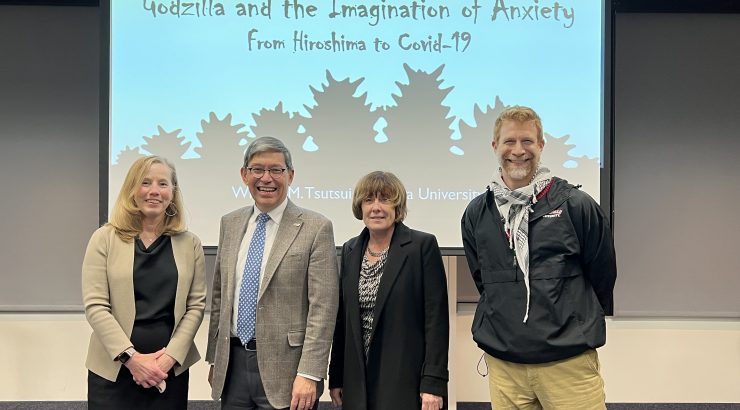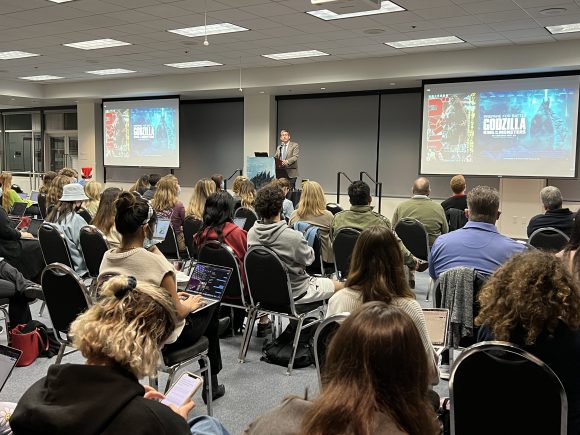
Godzilla and the Imagination of Anxiety
December 14, 2021
Wilkinson College’s Engaging the World: Leading the Conversation on Environmental Justice, recently welcomed Dr. Bill Tsutsui, President and CEO of Ottawa University, who presented “Godzilla and the Imagination of Anxiety, from Hiroshima to COVID-19.”
Walking the audience through Godzilla’s evolution, Tsutsui explained why he became so enamored with Godzilla at a young age, and continues to find the “big lizard” fascinating.
“I embraced Godzilla as something about Japan and something about my heritage that I could relate to and be proud of. Most of you don’t think of Godzilla as an ethnic hero, but he is one to me,” noted Tsutsui who grew up in College Station, Texas, at a time when the city’s population contained few Asian-Americans.
 In his lecture, the award-winning scholar and Godzilla super-fan explored how Godzilla served as a medium through which the Japanese people reclaimed their identity post-World War II and is also a tool for understanding and controlling environmental threats, past and present.
In his lecture, the award-winning scholar and Godzilla super-fan explored how Godzilla served as a medium through which the Japanese people reclaimed their identity post-World War II and is also a tool for understanding and controlling environmental threats, past and present.
“When we take a closer look at the ideology behind this movie, it is clear that Godzilla is profound, and the role that this monster plays is a symbol of how we imagine some of our greatest fears. I enjoyed how Dr. Tsutsui used his childhood stories to enlighten us about why this matters to him,” said Priyanka Sebeni (‘25, Creative Writing Major).
The first inception of Godzilla in the 1950s, Gojira, an irradiated monster that rises from the sea to wreak havoc on Japan, was conceived in the aftermath of Lucky Dragon 5 in 1954, when a Japanese fishing vessel strayed into the U.S. nuclear bomb testing zone near Bikini Atoll, resulting in the crew’s exposure to massive amounts of radiation. The incident, unacknowledged by the U.S., inspired the wartime, political film born in the aftermath of World War II.
Tsutsui emphasized the makers’ continued efforts to “mine headlines and address our collective fears” as the franchise evolved. Godzilla vs. The Smog Monster (1971) tackles issues of pollution and environmental awareness, while the more recent Hollywood films explore environmental anxieties in the aftermath of the disasters like the San Francisco Earthquake of 1989, the tsunami that hit Japan in 2011, and issues surrounding climate change.
“Godzilla’s very presence, the disruption he causes to the status quo, and the existential threat the monster causes to our lifestyle, our comforts, and our complacency keeps us asking the question we know we need to keep asking about issues like environment, war, nuclear energy, technology, and biosecurity,” said Tsutsui.
The unspoken and pervasive anxieties manifest from World War II, nuclear threat during the Cold War, and today, from the current, global COVID-19 pandemic all create ambient fear. Monsters like Godzilla emerge from this backdrop of ambient fear and allow us to “domesticate and disempower those things that threaten us” on the silver-screen.
Tsutsui addresses Godzilla’s persistence and popularity in today’s media. While invisible threats like COVID-19 virus are hard to imagine on the screen, cinematic monsters like Godzilla become physical manifestations of these fears that are “gigantic in scale and sweeping in impact.”
“Overall I am pretty grateful I went to this particular Engaging the World because it challenged me to think about movies in a way I haven’t thought about them before,” said Sebeni.
(Pictured in header (left to right): Wilkinson College Dean Jennifer Keene, Dr. Bill Tsutsui, Executive Vice President, Provost and Chief Academic Officer Norma Bouchard, Dr. Alex Bay)

